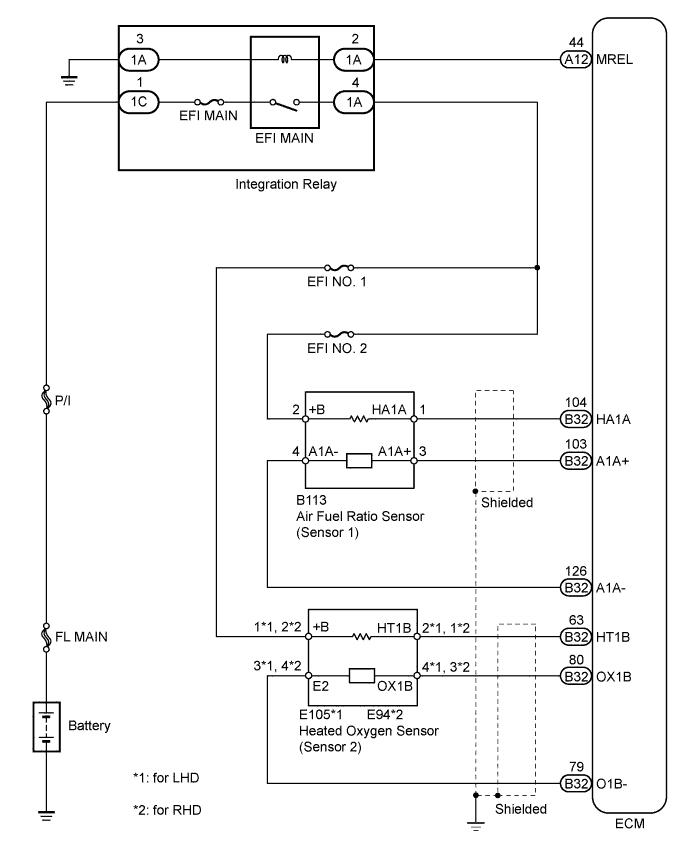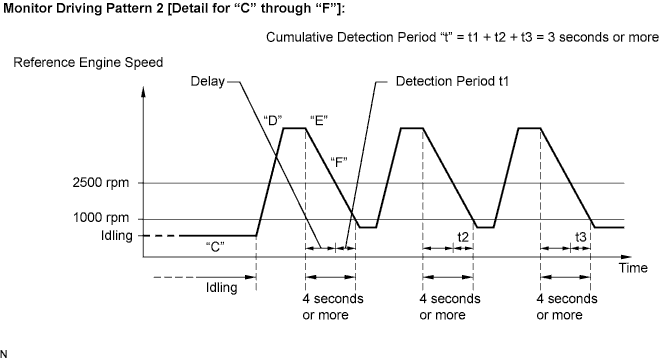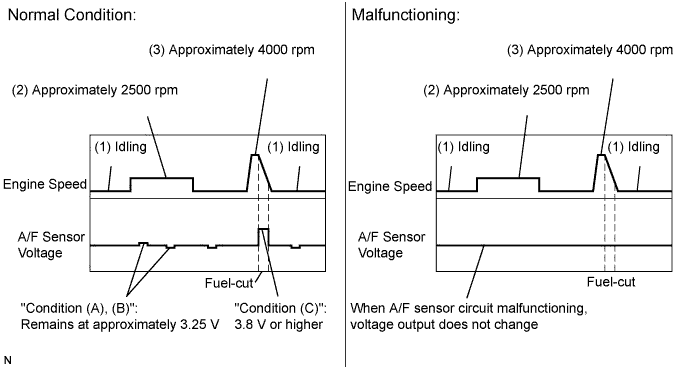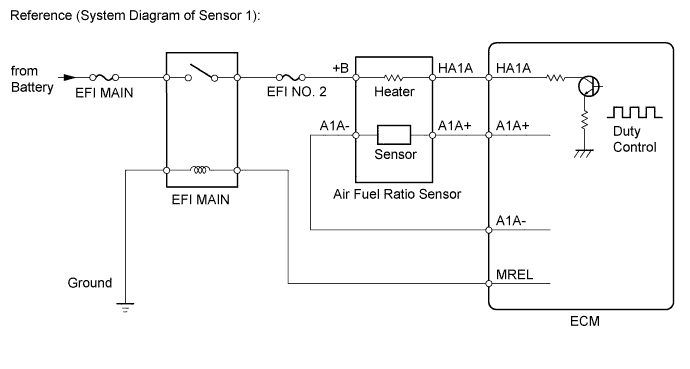Engine. Toyota Rav4. Aca30, 33, 38 Gsa33 Zsa30, 35
DESCRIPTION
WIRING DIAGRAM
CONFIRMATION DRIVING PATTERN
INSPECTION PROCEDURE
CHECK ANY OTHER DTCS OUTPUT (IN ADDITION TO P2195 OR P2196)
CONFIRM IF VEHICLE HAS RUN OUT OF FUEL IN PAST
READ VALUE USING INTELLIGENT TESTER (TEST VALUE OF AIR FUEL RATIO SENSOR)
READ VALUE USING INTELLIGENT TESTER (OUTPUT VOLTAGE OF AIR FUEL RATIO SENSOR)
REPLACE AIR FUEL RATIO SENSOR
PERFORM CONFIRMATION DRIVING PATTERN
CHECK WHETHER DTC OUTPUT RECURS (DTC P2195 OR P2196)
INSPECT AIR FUEL RATIO SENSOR (HEATER RESISTANCE)
CHECK AIR FUEL RATIO SENSOR (POWER SOURCE)
CHECK HARNESS AND CONNECTOR (AIR FUEL RATIO SENSOR - ECM)
CHECK INTAKE SYSTEM
CHECK FUEL PRESSURE
INSPECT INJECTOR ASSEMBLY
REPLACE AIR FUEL RATIO SENSOR
PERFORM CONFIRMATION DRIVING PATTERN
CHECK WHETHER DTC OUTPUT RECURS (DTC P2195 OR P2196)
CHECK HARNESS AND CONNECTOR (AIR FUEL RATIO SENSOR - INTEGRATION RELAY)
CHECK FUEL LINE
DTC P2195 Oxygen (A/F) Sensor Signal Stuck Lean (Bank 1 Sensor 1) |
DTC P2196 Oxygen (A/F) Sensor Signal Stuck Rich (Bank 1 Sensor 1) |
DESCRIPTION
- HINT:
- Although the DTC titles say oxygen sensor, these DTCs relate to the air fuel ratio sensor.
- Sensor 1 refers to the sensor mounted in front of the three way catalytic converter and located near the engine assembly.
The air fuel ratio sensor generates a voltage* that corresponds to the actual air fuel ratio. This sensor voltage is used to provide the ECM with feedback so that it can control the air fuel ratio. The ECM determines the deviation from the stoichiometric air fuel ratio and regulates the fuel injection time. If the air fuel ratio sensor malfunctions, the ECM is unable to control the air fuel ratio accurately.The air fuel ratio sensor is of the planar type and is integrated with a heater, which heats the solid electrolyte (zirconia element). This heater is controlled by the ECM. When the intake air volume is low (the exhaust gas temperature is low), a current flows into the heater to heat the sensor in order to facilitate accurate air fuel ratio detection. The heat generated by the heater is conducted to the solid electrolyte through the alumina, therefore the sensor activation is accelerated.A three way catalytic converter is used in order to convert the carbon monoxide, hydrocarbons and nitrogen oxide into less harmful substances. To allow the three way catalytic converter to function effectively, it is necessary to keep the air fuel ratio of the engine near the stoichiometric air fuel ratio.*: The value changes inside the ECM. Since the air fuel ratio sensor is a current output element, current is converted into a voltage inside the ECM. Any measurements taken at the air fuel ratio sensor or ECM connectors will show a constant voltage.
DTC No.
| DTC Detection Condition
| Trouble Area
|
P2195
| Conditions (a) and (b) continue for 10 seconds or more (2 trip detection logic):
(a) The air fuel ratio sensor voltage is higher than 3.8 V.
(b) The heated oxygen sensor voltage is 0.15 V or higher.
| - Open or short in air fuel ratio sensor (sensor 1) circuit
- Air fuel ratio sensor (sensor 1)
- Air fuel ratio sensor heater (sensor 1)
- Integration relay (EFI MAIN relay)
- Air fuel ratio sensor heater circuit
- ECM
|
While the fuel-cut operation is performed (during vehicle deceleration), the air fuel ratio sensor current is 3.6 mA or higher for 3 seconds (2 trip detection logic).
| - Air fuel ratio sensor (sensor 1)
- ECM
|
P2196
| Conditions (a) and (b) continue for 10 seconds or more (2 trip detection logic):
(a) The air fuel ratio sensor voltage is below 2.8 V for 10 seconds.
(b) The heated oxygen sensor voltage is below 0.6 V.
| - Open or short in air fuel ratio sensor (sensor 1) circuit
- Air fuel ratio sensor (sensor 1)
- Air fuel ratio sensor heater (sensor 1)
- Integration relay (EFI MAIN relay)
- Air fuel ratio sensor heater circuit
- ECM
|
While the fuel-cut operation is performed (during vehicle deceleration), the air fuel ratio sensor current is below 1.0 mA for 3 seconds (2 trip detection logic).
| - Air fuel ratio sensor (sensor 1)
- ECM
|
- HINT:
- When either of these DTCs is output, check the air fuel ratio sensor output voltage using the intelligent tester. Enter the following menus: Powertrain / Engine and ECT / Data List / AFS Voltage B1 S1.
- Short-term fuel trim values can also be read using the intelligent tester.
- The ECM regulates the voltages at the A1A+ and A1A- terminals of the ECM to a constant level. Therefore, the air fuel ratio sensor output voltage cannot be confirmed without using the intelligent tester.
- If the air fuel ratio sensor is malfunctioning, the ECM stores DTC P2195 or P2196.
WIRING DIAGRAM
CONFIRMATION DRIVING PATTERN
- This confirmation driving pattern is used in the "Perform Confirmation Driving Pattern" procedure of the following diagnostic troubleshooting procedure.
- Connect the intelligent tester to the DLC3.
- Turn the ignition switch to ON.
- Turn the tester on.
- Clear the DTCs (RAV4_ACA30 RM000000PDK0WCX.html).
- Start the engine, and warm it up until the engine coolant temperature reaches 75°C (167°F) or higher (Procedure "A").
- Using the intelligent tester, check the fuel-cut status. Enter the following menus: Powertrain / Engine and ECT / Data List / All Data / Idle Fuel Cut.
- Drive the vehicle at between 60 km/h (38 mph) and 120 km/h (75 mph) for at least 10 minutes (Procedure "B").
- Shift the transmission to 2nd gear (Procedure "C").
- Drive the vehicle at a proper vehicle speed to perform the fuel-cut operation (Procedure "D") (refer to the following HINT).
- HINT:
- Fuel-cut is performed when the following conditions are met:
- The accelerator pedal fully is released.
- The engine speed is 2500 rpm or more (fuel injection resumes at 1000 rpm).
- Accelerate the vehicle to 64 km/h (40 mph) or more by depressing the accelerator pedal for at least 10 seconds (Procedure "E").
- Soon after performing Procedure "E" above, release the accelerator pedal for at least 4 seconds without depressing the brake pedal in order to execute fuel-cut control (Procedure "F").
- Allow the vehicle to decelerate until the vehicle speed is less than 10 km/h (6 mph).
- Repeat the steps from Procedure "C" through Procedure "F" above at least 3 times in one driving cycle.
- CAUTION:
- Strictly observe posted speed limits, traffic laws, and road conditions when performing these driving patterns.
INSPECTION PROCEDURE
- HINT:
- Malfunctioning areas can be identified by performing the "Control the Injection Volume for A/F Sensor" function provided in the Active Test. The "Control the Injection Volume for A/F Sensor" function can help determine whether the air fuel ratio sensor, heated oxygen sensor and other potential trouble areas are malfunctioning.
The following instructions describe how to conduct the "Control the Injection Volume for A/F Sensor" operation using the intelligent tester.- Connect the intelligent tester to the DLC3.
- Start the engine.
- Turn the tester on.
- Warm up the engine at an engine speed of 2500 rpm for approximately 90 seconds.
- Enter the following menus: Powertrain / Engine and ECT / Active Test / Control the Injection Volume for A/F Sensor.
- Perform the "Control the Injection Volume for A/F Sensor" operation with the engine idling (press the RIGHT or LEFT button to change the fuel injection volume).
- Monitor the output voltages of the air fuel ratio and heated oxygen sensors (AFS Voltage B1 S1 and O2S B1 S2) displayed on the tester.
- HINT:
- The "Control the Injection Volume for A/F Sensor" operation decreases the fuel injection volume by 12.5% or increases the injection volume by 25%.
- The sensors react in accordance with increases and decreases in the fuel injection volume.
- Standard:
Tester Display
(Sensor)
| Injection Volume
| Status
| Voltage
|
AFS Voltage B1 S1
(A/F)
| +25%
| Rich
| Below 3.1
|
-12.5%
| Lean
| Higher than 3.4
|
O2S B1 S2
(HO2)
| +25%
| Rich
| Higher than 0.55
|
-12.5%
| Lean
| Below 0.4
|
- NOTICE:
- The air fuel ratio sensor has an output delay of a few seconds and the heated oxygen sensor (sensor 2) output has a maximum output delay of approximately 20 seconds.
Case
| A/F Sensor (Sensor 1) Output Voltage
| HO2 Sensor (Sensor 2) Output Voltage
| Main Suspected Trouble Area
|
1
| 

| 

| -
|
2
| 

| 

| - A/F sensor
- A/F sensor heater
- A/F sensor circuit
|
3
| 

| 

| - HO2 sensor
- HO2 sensor heater
- HO2 sensor circuit
|
4
| 

| 

| - Injector
- Fuel pressure
- Gas leak from exhaust system (Air fuel ratio extremely rich or lean)
|
- Following the "Control the Injection Volume for A/F Sensor" procedure enables technicians to check and graph the voltage outputs of both the air fuel ratio and heated oxygen sensors.
- To display the graph, enter the following menus: Powertrain / Engine and ECT / Active Test / Control the Injection Volume for A/F Sensor / AFS Voltage B1 S1 and O2S B1 S2.
- HINT:
- DTC P2A00 may be stored when the air fuel ratio is stuck rich or lean.
- Read freeze frame data using the intelligent tester. The ECM records vehicle and driving condition information as freeze frame data the moment a DTC is stored. When troubleshooting, freeze frame data can help determine if the vehicle was moving or stationary, if the engine was warmed up or not, if the air fuel ratio was lean or rich, and other data from the time the malfunction occurred.
- A low air fuel ratio sensor voltage could be caused by a rich air fuel mixture. Check for conditions that would cause the engine to run rich.
- A high air fuel ratio sensor voltage could be caused by a lean air fuel mixture. Check for conditions that would cause the engine to run lean.
- NOTICE:
- Inspect the fuses for circuits related to this system before performing the following inspection procedure.
| 1.CHECK ANY OTHER DTCS OUTPUT (IN ADDITION TO P2195 OR P2196) |
Connect the intelligent tester to the DLC3.
Turn the ignition switch to ON.
Turn the tester on.
Enter the following menus: Powertrain / Engine and ECT / DTC.
Read the DTCs.
ResultResult
| Proceed to
|
DTC P2195 or P2196 is output
| A
|
DTC P2195 or P2196 and other DTCs are output
| B
|
- HINT:
- If any DTCs relating to the air fuel ratio sensor (DTCs for the air fuel ratio sensor heater or air fuel ratio sensor admittance) are output, troubleshoot those DTCs first.
| 2.CONFIRM IF VEHICLE HAS RUN OUT OF FUEL IN PAST |
Has the vehicle run out of fuel in the past?
| YES |
|
|
|
| DTC CAUSED BY RUNNING OUT OF FUEL |
|
| 3.READ VALUE USING INTELLIGENT TESTER (TEST VALUE OF AIR FUEL RATIO SENSOR) |
Connect the intelligent tester to the DLC3.
Turn the ignition switch to ON.
Turn the tester on.
Clear the DTCs (RAV4_ACA30 RM000000PDK0WCX.html).
Drive the vehicle in accordance with the driving pattern described in Confirmation Driving Pattern.
Enter the following menus: Powertrain / Engine and ECT / Utility / Monitor Status.
Check that the status of "O2 Sensor" is "Complete".
If the status is still "Incomplete", drive the vehicle according to the driving pattern again.
- HINT:
- "Available" indicates that the component has not been monitored yet.
- "Complete" indicates that the component is functioning normally.
- "Incomplete" indicates that the component is malfunctioning.
Enter the following menus: Powertrain / Engine and ECT / Data List / AFS Current B1 S1.
Check the test value of the air fuel ratio sensor output current during fuel-cut (refer to Monitor Driving Pattern 2 [Detail for "C" through "F"] in Confirmation Driving Pattern).
ResultTest Value
| Proceed to
|
Within normal range (1.0 mA or higher, and below 3.6 mA)
| A
|
Outside normal range (below 1.0 mA, or 3.6 mA or higher)
| B
|
| 4.READ VALUE USING INTELLIGENT TESTER (OUTPUT VOLTAGE OF AIR FUEL RATIO SENSOR) |
Connect the intelligent tester to the DLC3.
Start the engine.
Turn the tester on.
Warm up the air fuel ratio sensor at an engine speed of 2500 rpm for 90 seconds.
Enter the following menus: Powertrain / Engine and ECT / Data List / AFS Voltage B1 S1 and Engine Speed / Function / Snap Shot Record.
Check the air fuel ratio sensor voltage 3 times, once under each of the following conditions:
While idling (for at least 30 seconds) (Step "A").
At an engine speed of approximately 2500 rpm (without any sudden changes in engine speed) (Step "B").
Engine speed raised to 4000 rpm and then accelerator pedal quickly release so that the throttle valve is fully closed (Step "C").
- Standard Voltage:
Condition
| A/F Sensor Voltage Variation
| Reference
|
Step "A" and Step "B"
| Remains at approximately 3.3 V
| Between 3.1 V and 3.4 V
|
Step "C"
| Increases to 3.8 V or higher
| Occurs during engine deceleration
(when fuel-cut performed)
|
- HINT:
- For more information, see the diagrams below.
- If the output voltage of the air fuel ratio sensor remains at approximately 3.3 V (see Malfunctioning diagram) under any conditions, including those above, the air fuel ratio sensor may have an open circuit (this will also happen if the air fuel ratio sensor heater has an open circuit).
- If the output voltage of the air fuel ratio sensor remains at either approximately 3.8 V or higher, or 2.8 V or less (see Malfunctioning diagram) under any conditions, including those above, the air fuel ratio sensor may have a short circuit.
- The ECM stops fuel injection (fuel cut) during engine deceleration. This causes a lean condition and results in a momentary increase in the air fuel ratio sensor output voltage.
- The ECM must establish a closed throttle valve position learned value to perform fuel cut. If the battery cable has been disconnected and reconnected, the vehicle must be driven over 16 km/h (10 mph) to allow the ECM to learn the closed throttle valve position.
- When the vehicle is driven:
The output voltage of the air fuel ratio sensor may be below 2.8 V during fuel enrichment. For the vehicle, this translates to a sudden increase in speed with the accelerator pedal fully depressed when trying to overtake another vehicle. The air fuel ratio sensor is functioning normally.
- The air fuel ratio sensor is a current output element; therefore, the current is converted into a voltage inside the ECM. Measuring the voltage at the connectors of the air fuel ratio sensor or ECM will show a constant voltage result.
| 5.REPLACE AIR FUEL RATIO SENSOR |
Replace the air fuel ratio sensor (RAV4_ACA30 RM000002WUR027X.html).
| 6.PERFORM CONFIRMATION DRIVING PATTERN |
| 7.CHECK WHETHER DTC OUTPUT RECURS (DTC P2195 OR P2196) |
Connect the intelligent tester to the DLC3.
Turn the ignition switch to ON.
Turn the tester on.
Enter the following menus: Powertrain / Engine and ECT / DTC.
Read the pending DTCs.
ResultResult
| Proceed to
|
DTC is not output
| A
|
DTC P2195 or P2196 is output
| B
|
| 8.INSPECT AIR FUEL RATIO SENSOR (HEATER RESISTANCE) |
Disconnect the air fuel ratio sensor connector.
Measure the resistance according to the value(s) in the table below.
- Standard Resistance:
Tester Connection
| Condition
| Specified Condition
|
1 (HA1A) - 2 (+B)
| 20°C (68°F)
| 1.8 to 3.4 Ω
|
1 (HA1A) - 4 (A1A-)
| Always
| 10 kΩ or higher
|
Text in Illustration*1
| Component without harness connected
(Air Fuel Ratio Sensor)
|
Reconnect the air fuel ratio sensor.
| 9.CHECK AIR FUEL RATIO SENSOR (POWER SOURCE) |
Disconnect the air fuel ratio sensor connector.
Measure the voltage according to the value(s) in the table below.
- Standard Voltage:
Tester Connection
| Switch Condition
| Specified Condition
|
B113-2 (+B) - Body ground
| Ignition switch ON
| 11 to 14 V
|
Text in Illustration*1
| Front view of wire harness connector
(to Air Fuel Ratio Sensor)
|
Reconnect the air fuel ratio sensor connector.
| 10.CHECK HARNESS AND CONNECTOR (AIR FUEL RATIO SENSOR - ECM) |
Disconnect the air fuel ratio sensor connector.
Disconnect the ECM connector.
Measure the resistance according to the value(s) in the table below.
- Standard Resistance (Check for Open):
Tester Connection
| Condition
| Specified Condition
|
B113-1 (HA1A) - B32-104 (HA1A)
| Always
| Below 1 Ω
|
B113-3 (A1A+) - B32-103 (A1A+)
| Always
| Below 1 Ω
|
B113-4 (A1A-) - B32-126 (A1A-)
| Always
| Below 1 Ω
|
- Standard Resistance (Check for Short):
Tester Connection
| Condition
| Specified Condition
|
B113-1 (HA1A) or B32-104 (HA1A) - Body ground
| Always
| 10 kΩ or higher
|
B113-3 (A1A+) or B32-103 (A1A+) - Body ground
| Always
| 10 kΩ or higher
|
B113-4 (A1A-) or B32-126 (A1A-) - Body ground
| Always
| 10 kΩ or higher
|
Text in Illustration*1
| Front view of wire harness connector
(to Air Fuel Ratio Sensor)
|
*2
| Front view of wire harness connector
(to ECM)
|
Reconnect the ECM connector.
Reconnect the air fuel ratio sensor connector.
| | REPAIR OR REPLACE HARNESS OR CONNECTOR (AIR FUEL RATIO SENSOR - ECM) |
|
|
Check the intake system for vacuum leakage (RAV4_ACA30 RM00000341000BX.html).
- OK:
- No leakage from intake system.
| | REPAIR OR REPLACE INTAKE SYSTEM |
|
|
Check the fuel pressure (RAV4_ACA30 RM000001IQZ02QX_01_0002.html).
| 13.INSPECT INJECTOR ASSEMBLY |
Check the injector injection (whether fuel volume is high or low, and whether injection pattern is poor) (RAV4_ACA30 RM000001EDQ01NX.html).
| 14.REPLACE AIR FUEL RATIO SENSOR |
Replace the air fuel ratio sensor (RAV4_ACA30 RM000002WUR027X.html).
| 15.PERFORM CONFIRMATION DRIVING PATTERN |
| 16.CHECK WHETHER DTC OUTPUT RECURS (DTC P2195 OR P2196) |
Connect the intelligent tester to the DLC3.
Turn the ignition switch to ON.
Turn the tester on.
Enter the following menus: Powertrain / Engine and ECT / DTC.
Read the pending DTCs.
ResultResult
| Proceed to
|
DTC is not output
| A
|
DTC P2195 or P2196 is output
| B
|
| 17.CHECK HARNESS AND CONNECTOR (AIR FUEL RATIO SENSOR - INTEGRATION RELAY) |
Disconnect the air fuel ratio sensor connector.
Remove the integration relay (A/F relay) from the engine room No. 1 relay block.
Disconnect the integration relay connector.
Measure the resistance according to the value(s) in the table below.
- Standard Resistance (Check for Open):
Tester Connection
| Condition
| Specified Condition
|
B113-2 (+B) - 1A-4
| Always
| Below 1 Ω
|
- Standard Resistance (Check for Short):
Tester Connection
| Condition
| Specified Condition
|
B113-2 (+B) or 1A-4 - Body ground
| Always
| 10 kΩ or higher
|
Text in Illustration*1
| Front view of wire harness connector
(to Air Fuel Ratio Sensor)
|
*2
| Front view of wire harness connector
(to Integration Relay)
|
*3
| Engine Room No. 1 Relay Block
|
Reconnect the air fuel ratio sensor connector.
Reconnect the integration relay connector.
Reinstall the integration relay.
| | REPAIR OR REPLACE HARNESS OR CONNECTOR (AIR FUEL RATIO SENSOR - INTEGRATION RELAY) |
|
|
Check the fuel lines for leaks or blockage.
| | REPAIR OR REPLACE FUEL LINE |
|
|

























